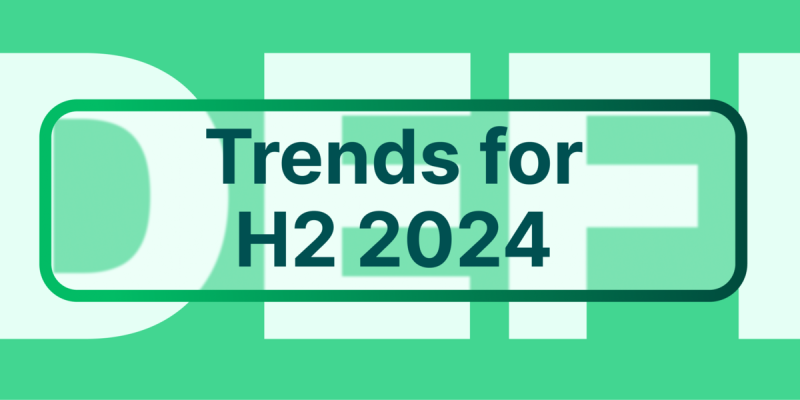[ad_1]
DeFi Developments for 2024
Seven DeFi traits for buyers to look at in 2024 embrace: Perpetual LP swimming pools, intents based mostly structure, the factors and airdrop meta, liquid staking protocols, cross chain bridging, actual world belongings, Bitcoin Layer 2s and different DeFi developments on the Bitcoin community, and prediction markets.
Key Takeaways
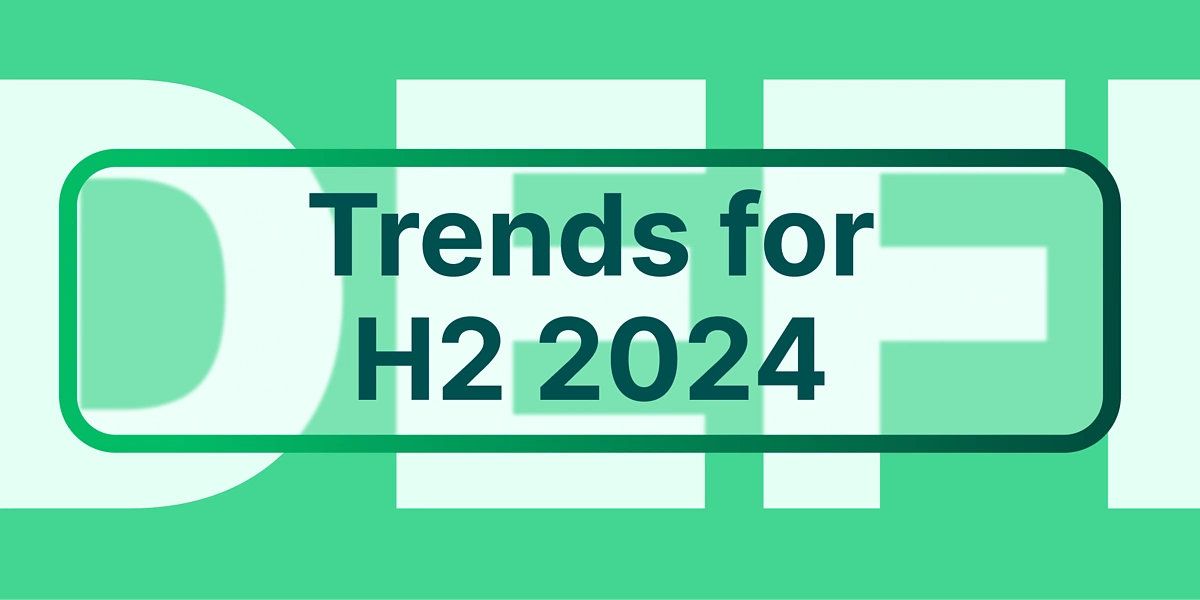
Since its inception in 2020, Decentralized Finance (DeFi) is arguably the largest innovation within the cryptocurrency area. DeFi boasts an alternate method to monetary companies, eradicating intermediaries like banks and brokers, and provides direct companies comparable to lending, buying and selling, and investments in a peer-to-peer, open, and clear method.
The full worth locked (TVL) in DeFi is now at $91.76 billion, which is a 53.49% drop from its peak of $176.25 billion in October 2022. Whereas this would possibly seem to be an enormous decline, there’s been a noticeable turnaround within the fourth quarter of 2023. The TVL has greater than doubled from its low of $36.59 billion in October 2023, displaying a transparent shift in market sentiment.
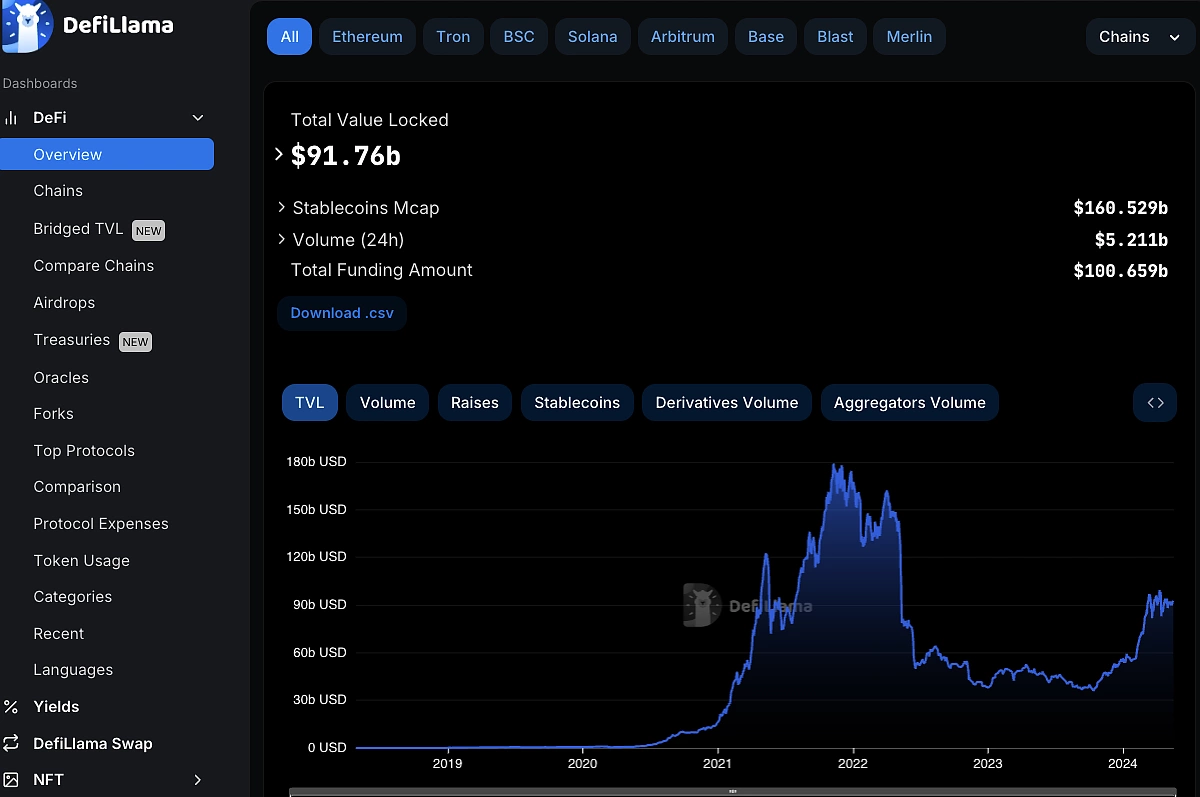
With 2024 shaping up as a restoration 12 months for cryptocurrencies, DeFi traits are additionally gaining momentum, each when it comes to protocol development and new capital inflows. At this time, we’re diving into seven DeFi traits you must hold an in depth eye on for the second half of 2024.
1. Perpetual LP Swimming pools Features Reputation in 2024 as Merchants Look to Leverage Up
The primary pattern could also be an unsexy one as it’s an idea the crypto market is properly accustomed to; nevertheless, it might simply be probably the most dependable because it capitalizes on ‘real yield’.
Liquidity Swimming pools (LP) are good contracts to lock up tokens to offer liquidity. They’re typically utilized by decentralized exchanges and lending protocols to facilitate token swaps and borrowing and lending actions, subsequently enjoying an necessary position in DeFi. They goal to garner enough liquidity to scale back slippage, particularly when coping with stablecoins and different extremely liquid belongings.
Whereas early LP Swimming pools have been constructed to facilitate peer-to-peer buying and selling, some protocols have advanced this idea in direction of “buying and selling in opposition to the home” as an alternative, particularly for perpetual buying and selling. This reduces the necessity for liquidity suppliers to pay shut consideration to their LP positions, and likewise permits broader “pooling” of yield because the liquidity supplier offers liquidity for the “home”. We take a look at two perpetual-based LP swimming pools you could possibly reap the benefits of incomes yields starting from 30% to 100% APY within the subsequent half of 2024.
GMX
GMX is a decentralized trade (DEX) that focuses on perpetual futures buying and selling, working on each Arbitrum and Avalanche networks. This platform permits customers to commerce cryptocurrencies with leverage, presenting a decentralized choice for derivatives buying and selling.
Liquidity in its LP swimming pools is represented by its token, GLP, consisting of 9 totally different belongings as proven under, starting from massive market capitalization belongings to a number of stablecoin pairs. GMX fees charges for trades made on the platform, together with perpetual futures buying and selling and spot swaps which shall be distributed to holders of GLP.
Successfully, by holding GLP, you earn a share of the buying and selling charges generated by the GMX platform on prime of incentives from the platform’s governance token, GMX. With a mixture of belongings (like Bitcoin, Ethereum, and stablecoins), holders of GLP won’t solely revenue from the appreciation of GLP, but in addition the efficiency of the underlying buying and selling swimming pools.
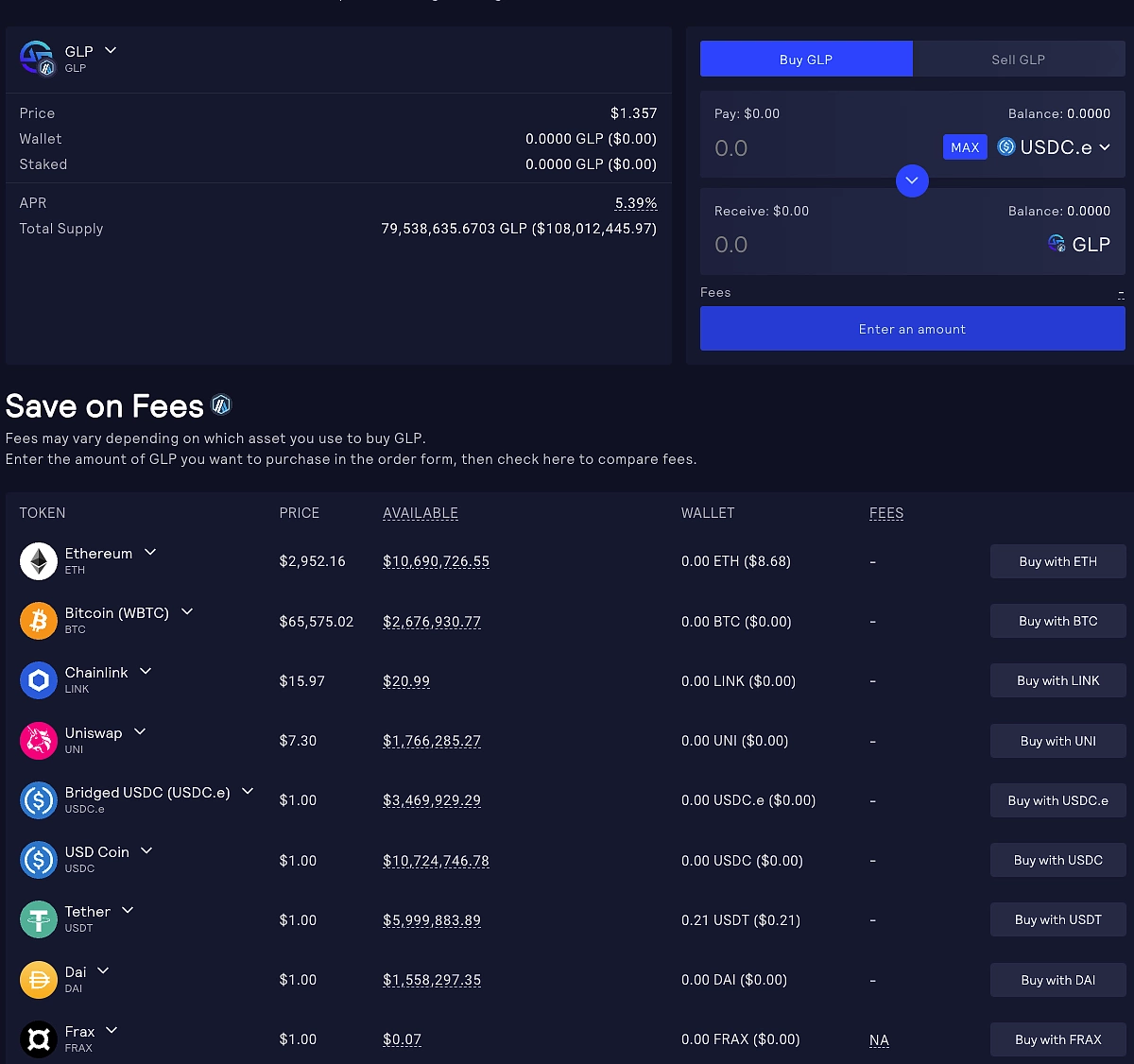
Jupiter
Jupiter is a well-liked liquidity aggregator on the Solana blockchain, recognized for offering optimum buying and selling routes throughout varied decentralized exchanges (DEXs) on Solana. Jupiter Liquidity Swimming pools (JLP) discuss with liquidity swimming pools created and utilized by Jupiter to facilitate environment friendly buying and selling.
In distinction to holding GLP, JLP has a smaller variety of underlying swimming pools, with solely 5 belongings in comparison with 9 in GLP. JLP at present yields holders as much as 80%-120% APY because it receives 70% of charges generated from perps buying and selling actions.
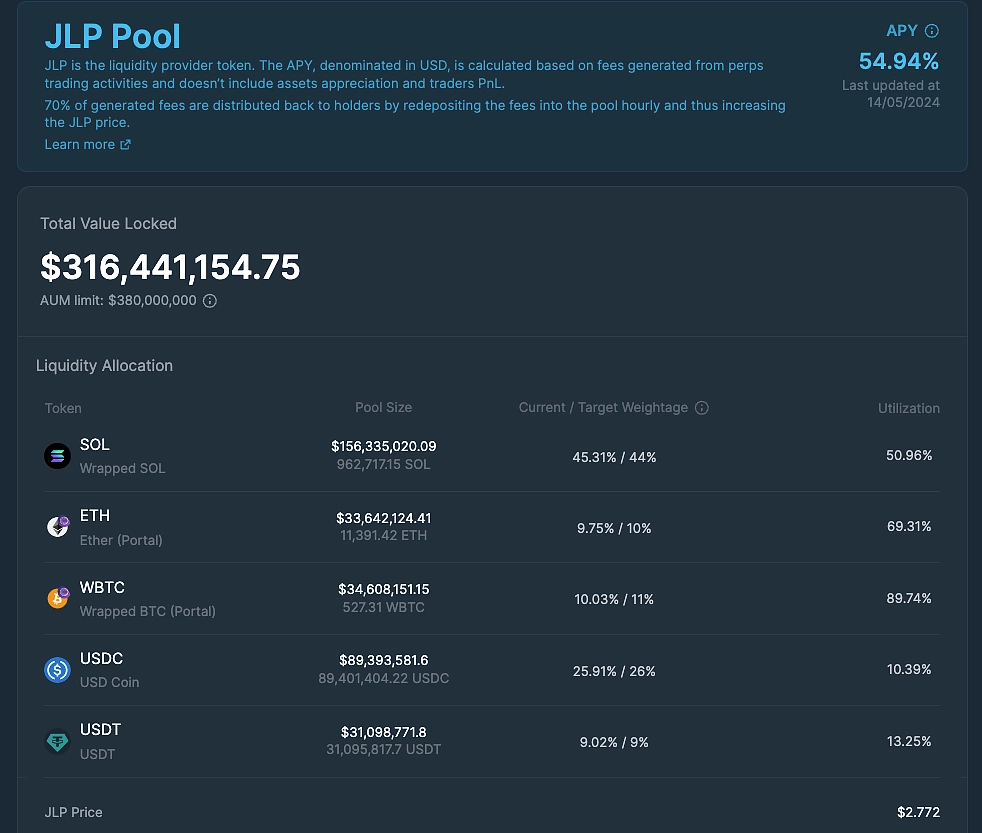
Allocation into an LP place may not yield members the best however poses another approach for getting publicity to the broader crypto markets throughout an upward rally. Though GLP and JLP holders might not outperform holding SOL, ETH, or BTC in a bull market, they are usually resilient, particularly in bearish market circumstances.
2. Intents Based mostly Structure
The present state of DeFi is commonly considered advanced and time-intensive, requiring customers to navigate and execute transactions throughout varied platforms and infrastructures. Historically, transactions specify “how” an motion needs to be executed. In distinction, intent-based methods outline “what” the specified final result of an motion needs to be.
With intent-based methods, customers can merely specify desired outcomes with no need to element each transaction parameter. This contrasts sharply with the normal transaction mannequin, which requires customers to explicitly outline every facet of their transactions.
For instance, a standard swap transaction would possibly seem like this: Swap 1 ETH for a minimum of 3700 USDC on the USDC-ETH pool on Uniswap with a most slippage of two%.
An intent-based transaction, then again, focuses on the result and requires a solver to find out one of the simplest ways to realize it. It would seem like this: Intent: I wish to get as a lot USDC as attainable by promoting 1 ETH.
The intent-based structure will get customers one of the best deal out there with no need to specify the platform for the swap or the timeframe for execution. Customers are spared from detailing each transaction parameter and navigating technical complexities, making the method extra user-friendly and environment friendly.
Within the crypto panorama at present, onboarding the following billion shall be a tall order largely resulting from UI/UX challenges. The cumbersome nature of making a pockets, transactions by means of a bridge, and doing swaps on-chain are all elements in dissuading the plenty. The concept of intent is to summary away all the issue and provides customers the absolute best final result in what they’re on the lookout for in crypto.
UniswapX
UniswapX is an instance of an intent-based protocol designed to beat the problem of inefficient routing throughout fragmented liquidity swimming pools. It’s an auction-based protocol the place customers can discover one of the best worth for his or her trades throughout Automated Market Makers (AMMs) and varied on/off-chain liquidity sources. Whereas the entrance finish of UniswapX seems largely much like Uniswap, the important thing variations lie within the again finish. As a substitute of customers approving transactions historically, their signatures are processed by means of UniswapX’s Filler community, which finds one of the best worth throughout centralized exchanges, Uniswap swimming pools, and DEX aggregators.
Aperture Finance
Aperture Finance is using AI-powered intents to streamline the complexities of DeFi. Constructed atop of Uniswap V3, Aperture permits customers to precise their finish objective for his or her LP place, which can solely be executed if it matches the person’s desired final result. Moreover, Aperture intends to reinforce its Giant Language Mannequin (LLM) interface to translate person intents, expressed in pure language, right into a domain-specific language (DSL) appropriate for on-chain implementation.
Intents could possibly be the important thing to attracting new members to DeFi and the broader crypto area by simplifying advanced jargon and devices and making them extra accessible. By simplifying interactions, optimizing processes, and selling broader adoption, intent-based structure will make it straightforward and simpler for a wider vary of clientele.
Airdrops are broadly employed in DeFi to stimulate person participation and liquidity. They assist in constructing communities and spreading consciousness about new tasks. As an illustration, the Compound airdrop in 2020, which distributed COMP tokens to customers, set a precedent that many different DeFi tasks adopted. This technique helps tasks bootstrap liquidity and person communities, whereas additionally distributing governance powers to customers to take part in the way forward for the venture.
Blur
Blur, an NFT aggregator platform, carried out a $450 million airdrop of BLUR tokens based mostly on person engagement. This strategic distribution not solely boosted the platform’s liquidity but in addition attracted vital curiosity from crypto airdrop farmers, who actively take part in such occasions to maximise their holdings. By introducing Blur factors as a method to incentivise person engagements comparable to itemizing and bidding of NFTs, these factors could be amassed and are sometimes used to find out person rankings, which qualify them for the token airdrop. Blur ensured the tokens got to these most certainly to make the most of them, enhancing the platform’s general utility and adoption whereas rising buying and selling exercise and visibility inside the NFT and broader crypto group.
EigenLayer
EigenLayer is a protocol constructed on prime of Ethereum and introduces restaking. It permits ETH to safe third companion protocols and is designed to offer safety companies with node operators anticipated to obtain a portion of the charges as service funds. Customers earn EigenPoints by staking, offering liquidity, and collaborating in governance selections, with factors calculated based mostly on the time-integrated quantity staked in ETH hours. This method has attracted over $15 billion in Whole Worth Locked (TVL), the place the amassed EigenPoints decide eligibility and allocation for the platform’s native token airdrop. This methodology promotes a decentralized and engaged group, rising the utility and adoption of EigenLayer’s companies whereas fostering a wholesome ecosystem of customers and contributors.
Ethena
Ethena is a stablecoin platform on the Ethereum blockchain which makes use of ETH as collateral by means of a course of known as delta-hedging. By launching a points-based program known as the “Shard Campaign” in February 2024 to incentivize person engagement, members earn Shards by offering liquidity and staking Ethena’s artificial greenback, USDe, in varied DeFi protocols comparable to Curve and Pendle. These Shards are later transformed into allocations of Ethena’s native token, ENA, which launched with a market cap of $1 billion. As of now, over $1.6 billion price of USDe has been minted, reflecting vital person engagement. This points-based method not solely promotes steady participation but in addition fosters a decentralized and energetic group, contributing to Ethena’s rising ecosystem with a Whole Worth Locked (TVL) surpassing $1.3 billion.
Solana’s Saga Smartphone
In an analogous vein, Solana’s Saga smartphone, designed with blockchain rules at its core, has leveraged airdrops to draw and reward customers. As an illustration, Saga cellphone homeowners acquired 30 million BONK tokens, considerably boosting the cellphone’s perceived worth and driving a surge in gross sales. Moreover, different airdrops, comparable to 100,000 ACS tokens from Entry Protocol and distinctive NFTs from the Saga Monkes venture, additional enhanced the attractiveness of proudly owning a Saga cellphone, resulting in excessive resale values on secondary markets.
Celestia
Equally, Celestia, a modular blockchain community, launched a big airdrop of 60 million TIA tokens in 2024 by means of its Genesis Drop. This airdrop focused builders and on-chain addresses on Ethereum rollups, Cosmos Hub, and Osmosis, inviting 7,579 builders and 576,653 on-chain addresses to take part. Eligibility was based mostly on particular standards, comparable to being energetic customers of prime Ethereum rollups or stakers on Cosmos Hub and Osmosis with a minimal steadiness. The airdrop aimed to foster group engagement and assist the community’s development by distributing tokens to early adopters and contributors, enhancing Celestia’s safety and scalability. Unclaimed tokens have been reallocated to energetic members, making certain complete distribution inside the ecosystem.
Airdrops are strategically used to create consciousness, construct communities, and kickstart token markets, typically rewarding customers for his or her interactions and contributions to the ecosystem. Because the crypto area continues to develop, airdrops will possible stay a key device for tasks to draw and retain customers.
4. Liquid Staking Protocols
Liquid staking protocols symbolize an development in conventional staking mechanisms by enabling stakers to retain liquidity whereas their belongings are locked in staking. That is achieved by means of the issuance of liquid staking tokens (LSTs), which act as derivatives of the staked belongings. These tokens could be utilized in varied DeFi actions, enhancing capital effectivity and adaptability.
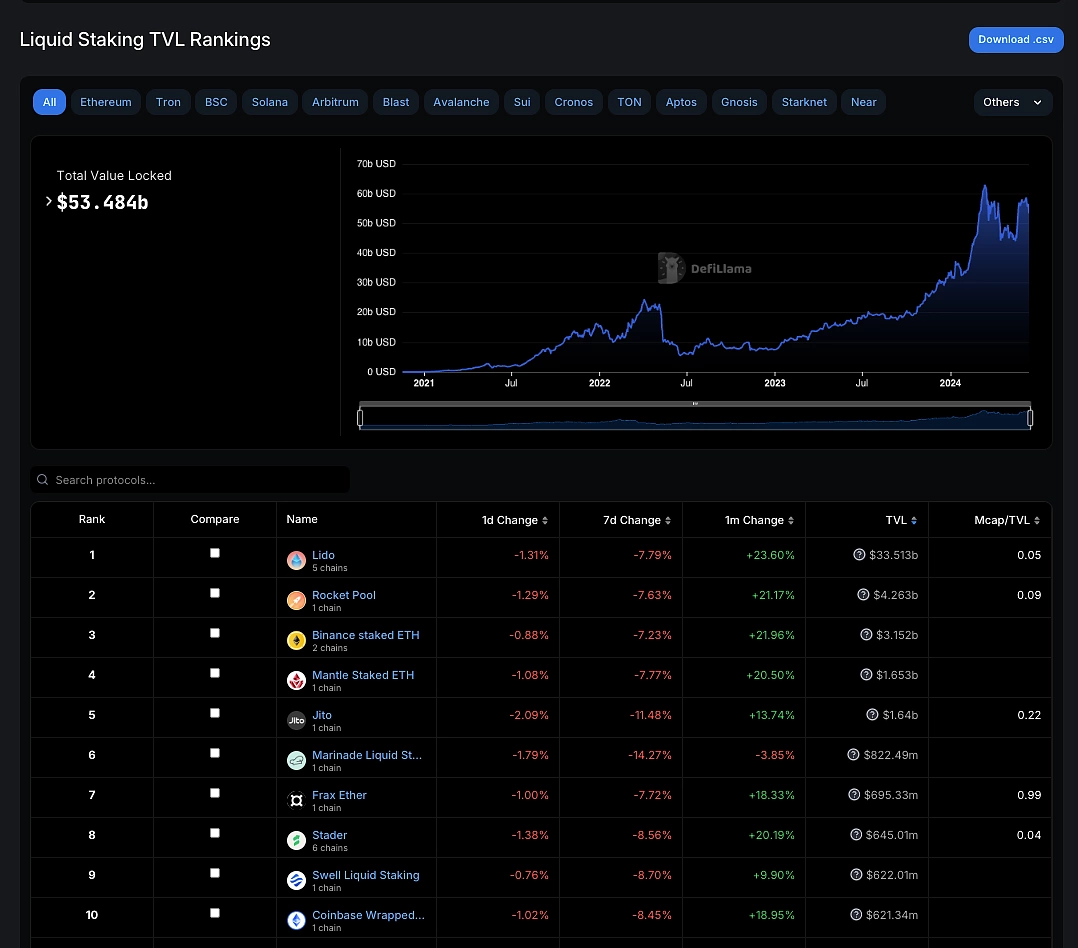
Lido Finance
Lido Finance is the biggest and hottest liquid staking platform, supporting a number of networks together with Ethereum, Polygon, and Solana. Customers can stake their tokens and obtain liquid staking tokens (stETH, stMATIC, stSOL) in return, which can be utilized throughout varied DeFi platforms. Lido holds over $14 billion in whole worth locked (TVL) and fees a ten% price on staking rewards. It provides an APY starting from 4.4% to six.7% relying on the community
When customers stake their belongings in a liquid staking protocol, they obtain LSTs equal to the worth of their staked belongings. For instance, when ETH is staked on Lido, customers obtain stETH tokens in return. These tokens are pegged to the underlying staked belongings, sustaining a 1:1 ratio. LSTs can be utilized in varied DeFi functions, together with lending, borrowing, yield farming, and liquidity provision, that means that whereas the unique belongings are incomes staking rewards, the LSTs can concurrently generate further yield within the DeFi ecosystem. This twin utility maximizes the potential returns on staked belongings and permits for extra dynamic funding methods.
The know-how behind liquid staking includes smart contracts, which automate the staking course of, mint LSTs, distribute rewards, and guarantee safety. These contracts are sometimes audited to stop vulnerabilities and make sure the integrity of the staking course of. Protocols like Frax Finance use Algorithmic Market Operations (AMO) to keep up the value stability of their liquid staking tokens, making certain that the LSTs carefully monitor the worth of the underlying belongings. Moreover, many liquid staking protocols make the most of decentralized autonomous organizations (DAOs) for governance. Token holders can vote on protocol modifications, price buildings, and different necessary selections, making certain that the platform evolves according to the group’s pursuits.
LSTs present stakers with the chance to earn further yields by means of DeFi methods comparable to yield farming and liquidity provision, making staking extra enticing and profitable. Whereas liquid staking introduces new dangers, comparable to good contract vulnerabilities and counterparty danger, many protocols implement sturdy safety measures, together with common audits and decentralized governance fashions, to mitigate these dangers.
Restaking
Rising traits embrace the rise of restaking protocols like EigenLayer, which provides Liquid Restaking Tokens (LRTs) for extra yield alternatives, and the enlargement into Layer 2 options with initiatives like Metis’s Liquid Staking Blitz. These developments, together with the potential regulatory approval of Ethereum spot ETFs, are anticipated to drive additional adoption and integration of liquid staking protocols. Because the DeFi ecosystem continues to evolve, liquid staking is ready to stay a dynamic and quickly rising sector, providing enhanced liquidity, capital effectivity, and yield alternatives for members.
5. Cross Chain Bridging
The appearance of cross-chain interoperability permits seamless transactions and asset transfers throughout varied blockchain networks. Based on L2Beat, bridges have a Whole Worth Locked (TVL) of over $9 billion, demonstrating the numerous influence and rising adoption on this sector.
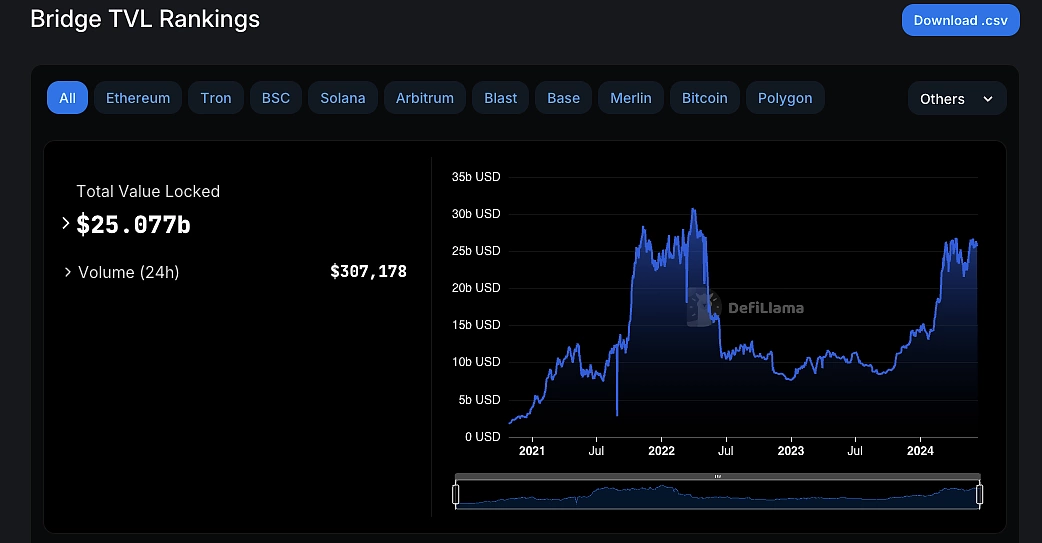
By means of cross-chain protocols, customers can entry a wider vary of DeFi companies past the restrictions of a single blockchain, thereby opening new avenues from decentralized lending and buying and selling to asset administration and yield farming.
Axelar
Axelar bridge is one instance that’s designed to attach a number of blockchain networks. It operates with the Hub and Spoke mannequin the place Axelar acts as a central hub, connecting varied blockchains (spokes). With over 25 chains built-in, DeFi protocols can leverage liquidity throughout chains, providing customers higher charges and extra choices for lending, borrowing and buying and selling. Protocols like Sommelier leverage Axelar to run yield methods throughout totally different networks, optimizing returns for customers. Moreover, JPMorgan’s Onyx Digital Belongings leverages Axelar for managing tokenized belongings, showcasing the protocol’s skill to assist large-scale monetary operations.
Hyperlane
A substitute for the Hub and Spoke mannequin, Hyperlane focuses on modularity and permissionless interoperability. It permits builders to deploy the protocol with no need approval from a government, decentralized functions (dApps) needn’t depend on a central hub however talk immediately from one dApp to a different, permitting for better customizability and decentralized management. Their integration with Celestia permits for cross-chain transfers of TIA between rollups.
Chainlink’s CCIP
Moreover, Chainlink’s Cross-Chain Interoperability Protocol (CCIP) enhances the DeFi ecosystem by enabling cross-chain liquidity swimming pools and interoperable DeFi protocols. By permitting liquidity swimming pools to span a number of blockchains, CCIP considerably improves liquidity and buying and selling alternatives, decreasing slippage, bettering commerce execution, and providing higher costs for merchants. Moreover, CCIP facilitates the seamless interplay of DeFi functions throughout varied networks, enabling protocols to leverage the distinctive options and advantages of every blockchain. As an illustration, a lending protocol can make the most of Ethereum’s excessive liquidity whereas benefiting from the low transaction charges of a Layer 2 answer like Polygon, leading to extra environment friendly, scalable, and cost-effective companies that improve general performance and person expertise.
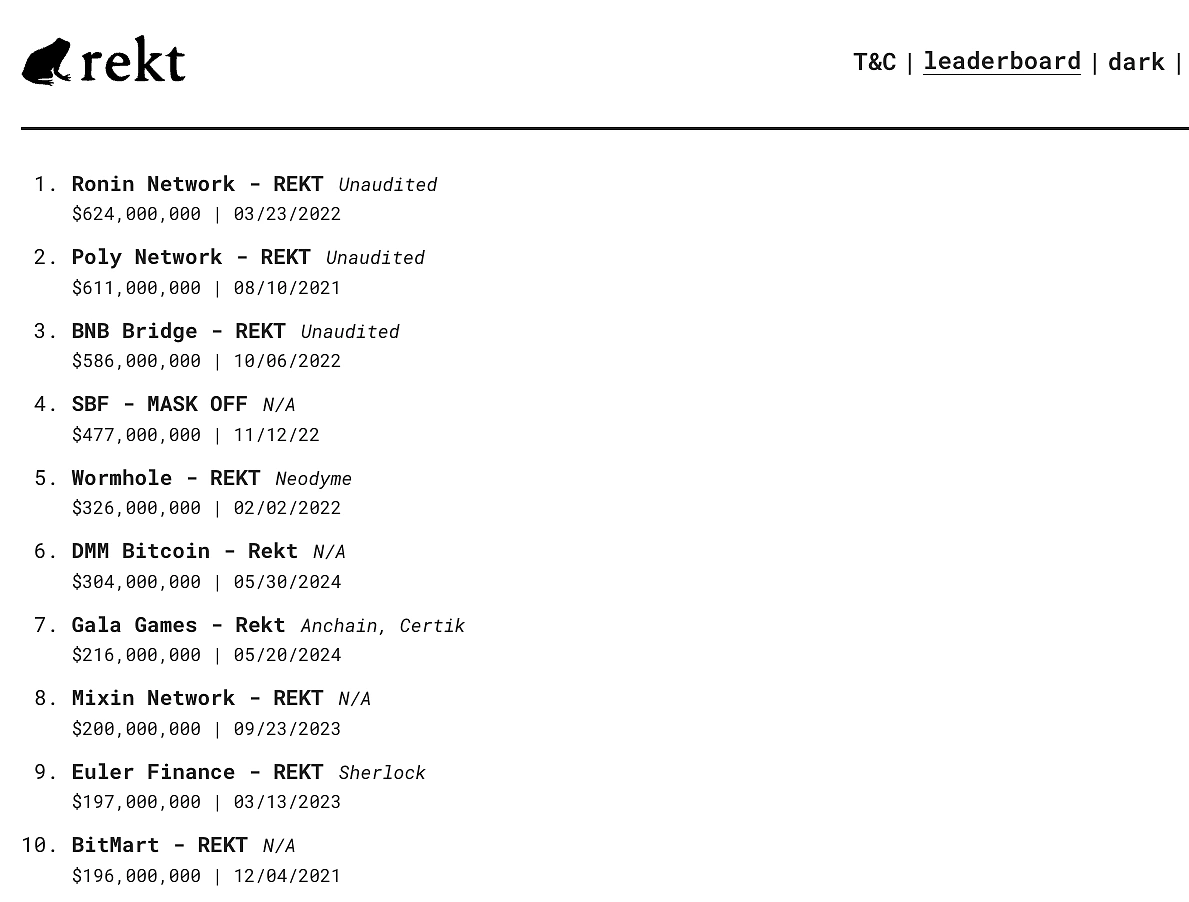
Whereas 5 of the ten largest hacks in Web3 have originated from bridge exploits as seen above, many protocols at the moment are prioritizing safety and danger administration. Kima Protocol, particularly, emphasizes safety by leveraging decentralized liquidity swimming pools, native pockets accounts, and AI-driven liquidity administration. Through the use of hardware-based safety measures and avoiding good contracts, oracles, and exterior relayers, Kima goals to considerably scale back the danger of hacks and safety breaches.
5. Actual-World Belongings
Real World Assets (RWA) tokenization includes remodeling bodily belongings into digital tokens or NFTs, facilitating their commerce on blockchain networks. This course of introduces alternatives for buyers and establishes a connection between typical and digital economies. RWAs maintain promise in offering steady yields, interesting to buyers in search of diversification into dependable revenue streams. Moreover, they promote international market participation by eliminating geographical constraints and decreasing entry obstacles.
With the collapse of FTX, Luna and 3AC in 2022, many flip to the RWA sector as a protected haven to retailer their belongings in crypto. Based on CoinGecko’s report on the Rise of Real Word Assets in Crypto, 2023 noticed an enormous improve in influx of tokenized treasuries by 782%, because the Whole Worth Locked (TVL) raised from $104 million in January 2023 to $917 million by the conclusion of 2023.
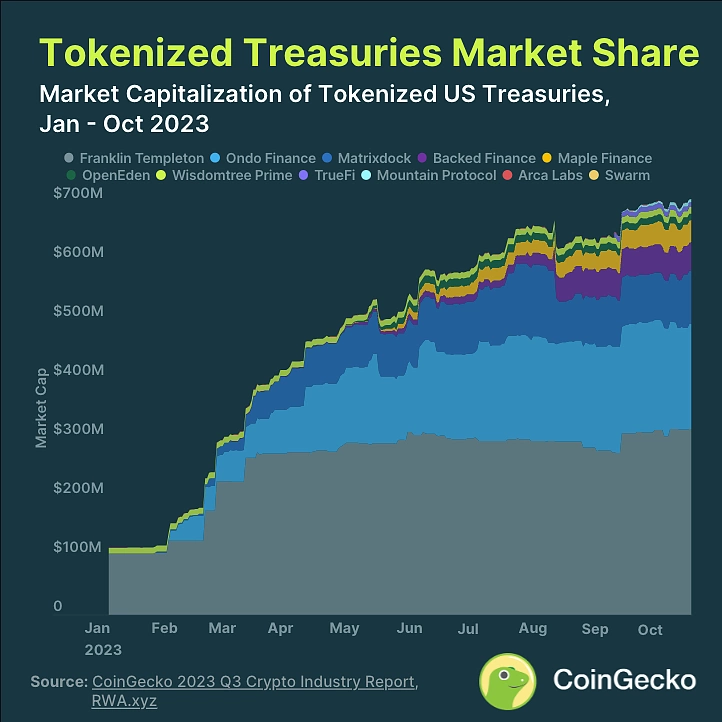
Realio
Realio community is an interoperable Layer 1 that helps real-world asset administration with open-source and permissionless infrastructure. Constructed on the Cosmos SDK, Realio operates utilizing two tokens: the Realio Community Token (RIO) and the Realio Safety Token (RST), and likewise options Ethereum Virtual Machine (EVM) compatibility. By means of tokenization, they plan to deliver RWAs onto the blockchain the place customers can tokenize their bodily or non-digital belongings to be represented as digital tokens. Realio permits them to be purchased, offered, and/or traded on digital platforms after being put by means of their authorized framework, making certain belongings are compliant with KYC/AML legal guidelines and securities laws.
Ondo Finance
Ondo Finance (ONDO) is one other RWA venture, which is without doubt one of the largest gamers within the $1.2 billion tokenized treasury market. They’re centered on bringing institutional-grade cash into the crypto area by way of Tokenizing T-Payments for yield with their USDY stablecoin. Over the previous months, there was notable development with its TVL peaking at $420 million, a 959% improve from 39.22 million in March 2023. Notably, Ondo Finance has secured backing from main gamers comparable to Pantera Capital, Coinbase, and Blackrock.
Swarm
Swarm markets is a decentralized buying and selling platform that enables institutional buyers to commerce and stake tokens based mostly on RWA comparable to commodities or monetary securities. They’re regulated by the German monetary authority and permit asset issuers to create token and liquidity swimming pools immediately on the platform. Customers should buy standard United States shares comparable to NVDA, COIN, MSFT, TSLA and immediately take part in DeFi swimming pools on the platform on the Polygon community permitting for better entry to the worldwide markets.
Whereas Actual World Belongings (RWA) might encounter hurdles in garnering adoption resulting from perceived dangers and regulatory ambiguity, quite a few tasks are emphasizing regulatory compliance. Because the sector progresses and matures, RWA persists as a big alternative to reshape conventional finance and introduce novel funding avenues. It stands as a noteworthy DeFi pattern to watch all through the rest of 2024.
6. A New Layer for Bitcoin
DeFi on Bitcoin is evolving, pushed by the event and adoption of Bitcoin Layer 2 solutions. These developments are enabling the creation of decentralized functions (DApps) on the Bitcoin community, overcoming earlier constraints of Bitcoin’s scripting capabilities.
Lightning Community
The Lightning Community facilitates instantaneous and low-cost Bitcoin transactions by means of off-chain cost channels. This know-how is essential for enabling micro-transactions and rising Bitcoin’s transaction throughput. As of 2024, the Lightning Community processes roughly 5,000 transactions per second (TPS), considerably greater than Bitcoin’s base layer capability of round 7 TPS. The community’s capability has grown to over 4,200 BTC, valued at over $100 million, indicating substantial adoption.
Stacks
Stacks brings Turing-complete good contracts to Bitcoin by means of its proof-of-transfer consensus mechanism. This permits builders to construct DApps immediately linked to the Bitcoin blockchain. Notable tasks on Stacks embrace Stackswap, a decentralized trade, Arkadiko, a DeFi lending platform, and CityCoins, a civic engagement and reward system. Stacks’ market capitalization has grown to over $1 billion, with greater than 300 DApps developed on its platform.
RSK
RSK operates as a Bitcoin sidechain, enabling good contract performance by means of merged mining with Bitcoin. This ensures excessive safety whereas permitting the execution of advanced DeFi functions. RSK hosts a number of DeFi tasks, together with Sovryn and Cash on Chain. The RSK community has locked over 1,500 BTC, price roughly $40 million.
Liquid Community
Developed by Blockstream, the Liquid Community provides quick and confidential transactions, issuance of digital belongings, and assist for good contracts. Liquid Bitcoin (L-BTC) is used inside the community to facilitate these functionalities. The Liquid Community handles over 10,000 transactions each day, with a complete transaction quantity exceeding $2 billion since its inception.
Rising traits embrace the introduction of BRC-20 tokens, enabling fungible token creation on Bitcoin, much like Ethereum’s ERC-20 customary. This growth is attracting builders to construct DeFi functions using Bitcoin’s safety. Protocols like RSK and Stacks present compatibility with the Ethereum Digital Machine (EVM), permitting builders to port Ethereum-based DApps to the Bitcoin ecosystem. This compatibility has led to over 200 Ethereum dApps being tailored to be used on Bitcoin.
The event of DeFi on Bitcoin, notably by means of Layer 2 options, is remodeling the ecosystem. Builders are constructing subtle dApps that leverage Bitcoin’s safety and these superior applied sciences to deliver DeFi functionalities to Bitcoin holders. The full worth locked (TVL) in Bitcoin DeFi tasks has surpassed $1 billion, reflecting rising participation in Bitcoin-based DeFi options. As these Layer 2 options evolve, they may play a vital position in increasing Bitcoin’s capabilities, driving innovation, and solidifying its place within the DeFi panorama.
7. Prediction Markets
Prediction markets, the place customers commerce and speculate on future occasions, have traditionally struggled to achieve vital consideration or capital within the DeFi ecosystem resulting from regulatory challenges and the issue of attaining the best product-market match. Nonetheless, current knowledge means that these markets are gaining momentum, with whole worth locked (TVL) reaching $55.1 million in early 2024, a 57.7% improve year-to-date. This development signifies that prediction markets may be lastly discovering their footing inside DeFi.
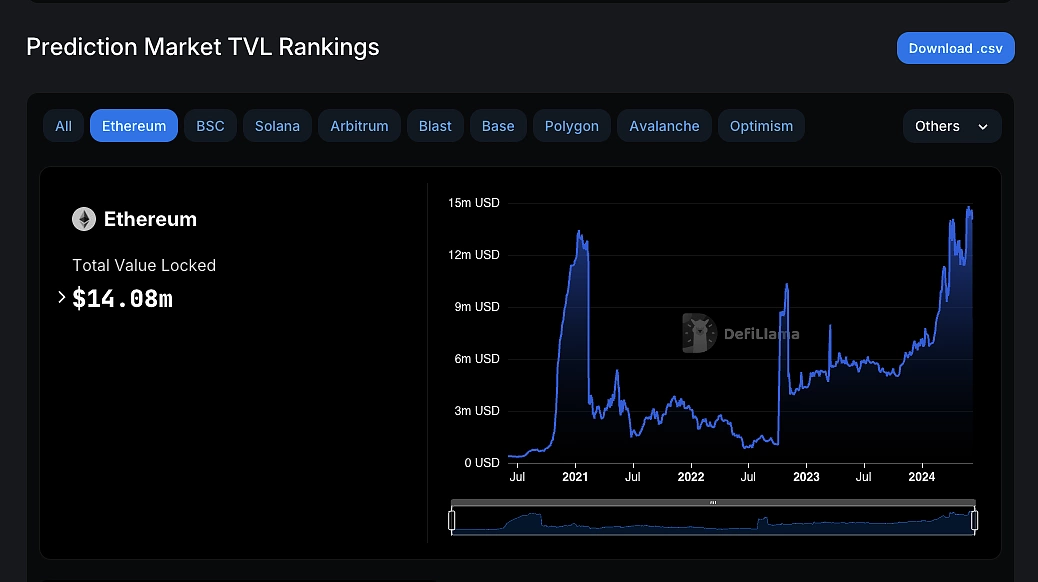
Main occasions drive demand for prediction markets, and 2024 is a big 12 months with elections in eight of the ten most populous nations, together with the extremely anticipated U.S. Presidential election. These occasions create alternatives for hypothesis, contributing to the expansion of prediction markets and their integration into the broader DeFi panorama. Prediction markets leverage the knowledge of crowds to mixture predictions, which may theoretically scale back info asymmetry and align market odds with precise outcomes. This enhances knowledge high quality, information accuracy, and public discourse.
Polymarket
Polymarket, constructed on Polygon, stands out as a number one on-chain prediction market. It has seen substantial development in 2024, with common month-to-month buying and selling volumes rising from $6.1 million in 2023 to $42.0 million. This development is highlighted by Polymarket’s buying and selling exercise and its current $45 million Sequence B funding spherical, bringing its whole funding to $70 million. The rise in buying and selling volumes and energetic person base, from 1,600 on the finish of 2023 to three,800 in 2024, signifies a solidifying presence inside the DeFi ecosystem.
Polymarket covers a variety of subjects, permitting customers to invest on varied classes, together with sports activities, politics, and popular culture. The variety of open markets has elevated, with the share of energetic markets rising from 0.32% to 0.37% in 2024. This variety enriches the DeFi area by providing extra engagement avenues for customers.
The present market upswing has introduced extra customers and liquidity to Polymarket, laying a powerful basis for future development. Traditionally, Polymarket has generated vital traction from political occasions, accumulating over $50 million in volumes from the earlier U.S. election. With over $128 million already wager on the upcoming election, Polymarket is well-positioned to capitalize on this curiosity, additional integrating prediction markets into the DeFi framework.
The 2024 U.S. Presidential election and upcoming UEFA Euro Cup 2024 current a big alternative for Polymarket to cement its place as a number one prediction market in DeFi. As Polymarket grows, it would play a vital position in integrating prediction markets into the broader DeFi ecosystem, providing invaluable insights into collective expectations. Leveraging blockchain know-how for transparency and safety, Polymarket boosts person engagement and contributes to DeFi’s general development and innovation.
Abstract
DeFi is at a pivotal second, gaining traction in each main and area of interest markets resulting from new developments and narratives. The sector is evolving, constructing on the inspiration of early areas like DEXes to supply beforehand inaccessible monetary primitives on-chain.
The rising significance of those new markets is evident because the push for expanded on-chain presence will increase. Current market uptrends and developments like spot ETF approvals and asset tokenization are attracting extra institutional liquidity and participation. This exhibits the necessity for the DeFi ecosystem to offer instruments that meet numerous market calls for and retain new demand and liquidity on-chain.
Rising markets are introducing new varieties of derivatives, revolutionary on-chain yield paradigms, CEX-like buying and selling merchandise, and extra capital-efficient lending designs. These improvements enhance effectivity in decentralized markets and bridge the hole between DeFi and TradFi.
Regardless of the optimistic outlook, challenges comparable to liquidity fragmentation, composability, and person expertise hinder widespread adoption. Moreover, new applied sciences deliver inherent dangers.
As these markets mature, we count on a shift in direction of a extra consolidated market construction centered round just a few dominant approaches. Over the following 12 months, DeFi will possible proceed to vary, evolving considerably from its early iterations. The fast tempo of innovation means that the following technology of economic primitives is on the horizon. Will probably be fascinating to see which markets and protocols thrive in the long run.
[ad_2]
Source link


